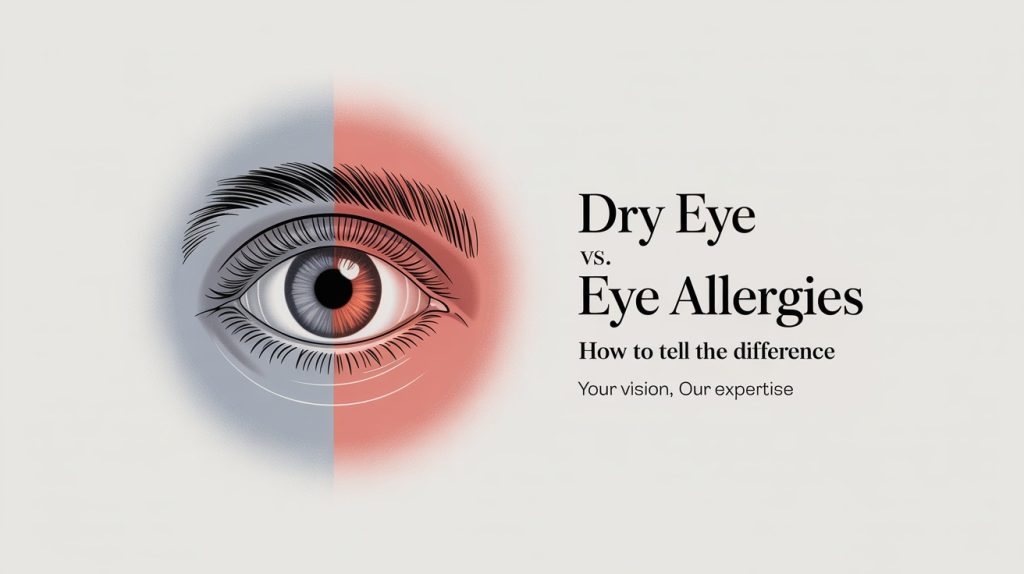So your eyes are irritated, and you’re wondering… is it dry eye or allergies?
Let’s walk through how to tell the difference, what overlaps, and when you should see an optometrist in Palo Alto to be sure.
Why it’s so easy to mix them up
Dry eye and eye allergies can cause the exact same complaints:
- Redness
- Irritation
- Watery eyes
- Blurry vision
The problem is, the treatment for one isn’t always the treatment for the other. If you’re using allergy drops but actually have dry eye, you might not feel better — and vice versa. That’s why it’s important to know the clues.
What is dry eye, exactly?
Dry eye happens when your tears don’t keep your eyes moist enough. This could be because:
- You’re not making enough tears.
- Your tears evaporate too fast.
- The oil glands in your eyelids (meibomian glands) are blocked.
If you work on a computer all day, blink less often, or spend time in heated/air-conditioned spaces, your eyes can dry out faster.
What are eye allergies?
Eye allergies happen when your immune system overreacts to something harmless — pollen, dust, pet hair, mold — and sends histamines to fight it off. The result?
- Itching (this is the big one)
- Redness
- Swelling
- Watering

The easiest way to tell them apart
| Symptom | More Likely Dry Eye | More Likely Allergies |
| Itching | Rare | Common |
| Burning | Common | Rare |
| Gritty/sandy feeling | Common | Rare |
| Watery eyes | Sometimes | Common |
| Seasonal flare-ups | Rare | Common |
| Worse with screens | Common | Rare |
If your main complaint is itching, allergies are the top suspect. If it’s burning or gritty feeling, dry eye’s more likely.
The confusing part — you can have both
Here’s the plot twist: dry eye and allergies often show up together. Allergies can inflame the eye’s surface, which messes with your tear film, making dry eye worse. And if you already have dry eye, allergens can irritate your eyes more easily.
That’s why at Refine Optometry, we never just assume — we actually test your tear quality and look for signs of allergy-related inflammation.
How dry eye is treated
If we confirm it’s dry eye, we might:
- Recommend preservative-free artificial tears.
- Treat meibomian gland blockages with heat therapy or IPL.
- Suggest omega-3 supplements for better tear quality.
- Adjust your screen habits (yes, that means blinking more!).
How eye allergies are treated
If allergies are the main issue, the plan changes:
- Antihistamine/mast cell stabilizer eye drops.
- Cold compresses to calm swelling.
- Avoiding triggers (keep windows shut on high-pollen days in Palo Alto).
- Wearing wraparound sunglasses outside.
Home tips that help both conditions
Even though treatments differ, there are some things that help no matter what’s going on:
- Don’t rub your eyes (We know it feels good, but it makes things worse).
- Use a humidifier if your home or office air is dry.
- Stay hydrated — your eyes need water just like the rest of you.
- Take breaks from screens to give your eyes a chance to recover.
When will you see an optometrist
If your symptoms aren’t going away after a week of trying home remedies, or they keep coming back, it’s time for a proper exam.
Know hen you should call our optometrist in Palo Alto right away:
- Vision changes that don’t clear up.
- Eye pain or light sensitivity.
- Over-the-counter drops aren’t helping.
Final takeaway
Dry eye and eye allergies share a lot of symptoms, but the main differences are itching (allergies) versus burning/grittiness (dry eye). The tricky part? You can absolutely have both. That’s why seeing an experienced Palo Alto optometry team can save you weeks of trial and error.
body { font-family: ‘Inter’, sans-serif; }Want to Learn More About Fitness App Types?
Dive deeper into the different types of fitness apps and find out which one is the perfect fit for your next project.

